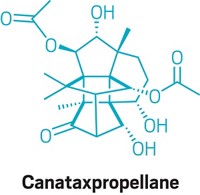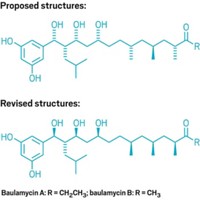Advertisement
Grab your lab coat. Let's get started
Welcome!
Welcome!
Create an account below to get 6 C&EN articles per month, receive newsletters and more - all free.
It seems this is your first time logging in online. Please enter the following information to continue.
As an ACS member you automatically get access to this site. All we need is few more details to create your reading experience.
Not you? Sign in with a different account.
Not you? Sign in with a different account.
ERROR 1
ERROR 1
ERROR 2
ERROR 2
ERROR 2
ERROR 2
ERROR 2
Password and Confirm password must match.
If you have an ACS member number, please enter it here so we can link this account to your membership. (optional)
ERROR 2
ACS values your privacy. By submitting your information, you are gaining access to C&EN and subscribing to our weekly newsletter. We use the information you provide to make your reading experience better, and we will never sell your data to third party members.
Biological Chemistry
Thiostrepton from Scratch
First total synthesis of complex antibiotic with unusual mechanism
by Stu Borman
September 27, 2004
| A version of this story appeared in
Volume 82, Issue 39
ORGANIC SYNTHESIS
First total synthesis of complex antibiotic with unusual mechanism
Thiostrepton, an extraordinarily complex bacterial natural product that's used as a topical veterinary antibiotic and also has promising antimalarial and anticancer activity, has yielded to total chemical synthesis.
First isolated from bacteria in 1955, thiostrepton has an unusual type of antibiotic activity: It disables protein biosynthesis by binding to ribosomal RNA and one of its associated proteins. British crystallographer and 1964 Nobel Prize winner Dorothy Crowfoot Hodgkin solved the structure in 1970.
Thiostrepton includes 10 rings, 11 peptide bonds, extensive unsaturation, and 17 stereogenic centers. More challenging still, it is highly acid- and base-sensitive. It's the parent compound and the most complex member of a family of thiopeptide antibiotics.
Now, the compound has succumbed to the synthetic blandishments of chemistry professor K. C. Nicolaou and coworkers at Scripps Research Institute and the University of California, San Diego [Angew. Chem. Int. Ed., 43, 5087 and 5092 (2004)].
"It's a landmark synthesis and an outstanding achievement by the Nicolaou group," comments senior research fellow Christopher J. Moody of the department of chemistry at the University of Exeter, in England. Moody's group had earlier synthesized two smaller thiopeptide antibiotics, promothicin and amythiamicin D.
The linchpin of thiostrepton's structure is a dehydropiperidine ring that supports a bisdehydroalanine tail and two macrocycles--a 26-membered thiazoline-containing ring and a 27-membered quinaldic acid system. Nicolaou and coworkers created the critical dehydropiperidine ring from simple starting materials through a biomimetic hetero-Diels-Alder dimerization. This key step helps validate a 1978 proposal that bacteria use this kind of reaction to biosynthesize thiopeptide antibiotics.
Nicolaou and coworkers incorporated the dehydropiperidine into the thiazoline-containing macrocycle. They combined that macrocycle with a quinaldic acid-containing structure and a bisdehydroalanine-tail precursor unit. They then elaborated the product to obtain thiostrepton.
A reviewer of the group's two papers says the synthesis "is a masterpiece that highlights state-of-the-art technique and opens the field to meaningful structure-activity and mode-of-action studies."






Join the conversation
Contact the reporter
Submit a Letter to the Editor for publication
Engage with us on Twitter